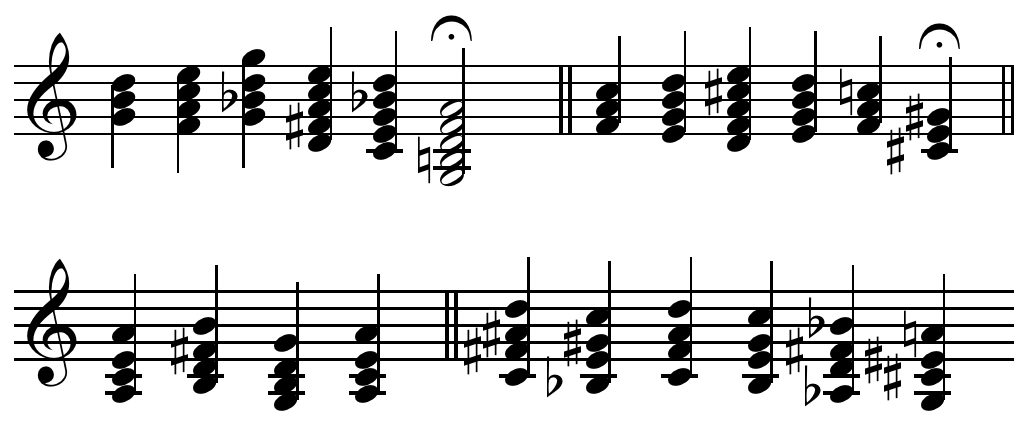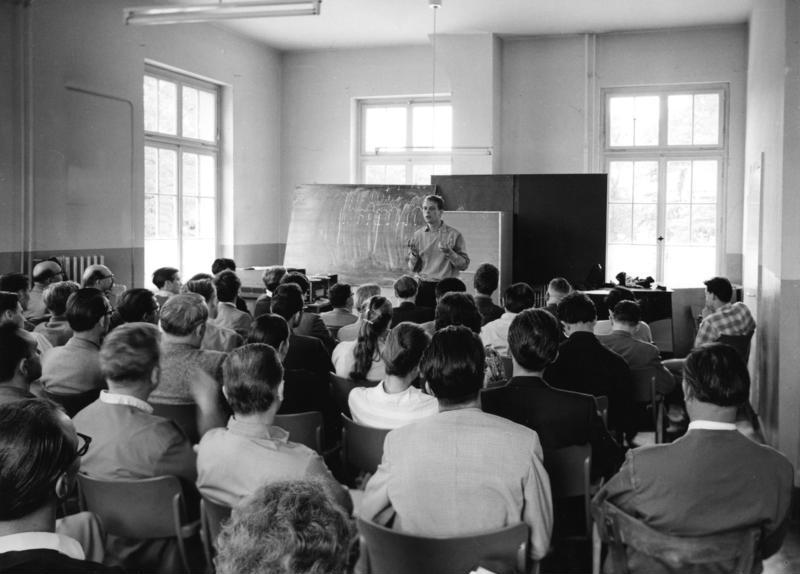|
Lento (Skempton)
''Lento'' is a composition for orchestra written by Howard Skempton in 1990. It was Skempton's third work for large forces, and his first major success. The piece was commissioned by the BBC Symphony Orchestra. Skempton was to write a piece to be performed between the Prelude from Richard Wagner's ''Parsifal'' and a Deryck Cooke completion of Gustav Mahler's Tenth Symphony. Skempton initially set out to compose three short pieces to be played in sequence, but afterwards decided on a single large piece. ''Lento'' was completed in November 1990; it was premiered on 12 March 1991 by the BBC Symphony Orchestra at the Barbican Centre concert hall, conducted by Mark Wigglesworth. The work is scored for 3 flutes, 3 oboes, cor anglais, clarinet, 3 bassoons, contrabassoon, 4 horns, 3 trumpets, 3 trombones, tuba, timpani, and strings. The instrumentation is the same as that of Wagner's ''Parsifal'' prelude, although Skempton's use of instruments is very different. Most of ''Lento'' is scored ... [...More Info...] [...Related Items...] OR: [Wikipedia] [Google] [Baidu] |
Howard Skempton
Howard While Skempton (born 31 October 1947) is an English composer, pianist, and accordionist. Since the late 1960s, when he helped to organise the Scratch Orchestra, he has been associated with the English school of experimental music. Skempton's work is characterised by stripped-down, essentials-only choice of materials, absence of formal development and a strong emphasis on melody. The musicologist Hermann-Christoph Müller has described Skempton's music as " the emancipation of the consonance". Life Skempton was born in Chester and studied at Birkenhead School and Ealing Technical College.Potter, Grove. He started composing before 1967, but that year he moved to London and began taking private lessons in composition from Cornelius Cardew. In 1968 Skempton joined Cardew's experimental music class at Morley College, where in spring 1969 Cardew, Skempton and Michael Parsons organised the Scratch Orchestra. This ensemble, which had open membership, was dedicated to performin ... [...More Info...] [...Related Items...] OR: [Wikipedia] [Google] [Baidu] |
Trumpet
The trumpet is a brass instrument commonly used in classical and jazz ensembles. The trumpet group ranges from the piccolo trumpet—with the highest register in the brass family—to the bass trumpet, pitched one octave below the standard B or C trumpet. Trumpet-like instruments have historically been used as signaling devices in battle or hunting, with examples dating back to at least 1500 BC. They began to be used as musical instruments only in the late 14th or early 15th century. Trumpets are used in art music styles, for instance in orchestras, concert bands, and jazz ensembles, as well as in popular music. They are played by blowing air through nearly-closed lips (called the player's embouchure), producing a "buzzing" sound that starts a standing wave vibration in the air column inside the instrument. Since the late 15th century, trumpets have primarily been constructed of brass tubing, usually bent twice into a rounded rectangular shape. There are many distinc ... [...More Info...] [...Related Items...] OR: [Wikipedia] [Google] [Baidu] |
1990 Compositions
Year 199 ( CXCIX) was a common year starting on Monday (link will display the full calendar) of the Julian calendar. At the time, it was sometimes known as year 952 ''Ab urbe condita''. The denomination 199 for this year has been used since the early medieval period, when the Anno Domini calendar era became the prevalent method in Europe for naming years. Events By place Roman Empire * Mesopotamia is partitioned into two Roman provinces divided by the Euphrates, Mesopotamia and Osroene. * Emperor Septimius Severus lays siege to the city-state Hatra in Central-Mesopotamia, but fails to capture the city despite breaching the walls. * Two new legions, I Parthica and III Parthica, are formed as a permanent garrison. China * Battle of Yijing: Chinese warlord Yuan Shao defeats Gongsun Zan. Korea * Geodeung succeeds Suro of Geumgwan Gaya, as king of the Korean kingdom of Gaya (traditional date). By topic Religion * Pope Zephyrinus succeeds Pope Victor I, as the ... [...More Info...] [...Related Items...] OR: [Wikipedia] [Google] [Baidu] |
Emancipation Of The Dissonance
The emancipation of the dissonance was a concept or goal put forth by composer Arnold Schoenberg and others, including his pupil Anton Webern. The phrase first appears in Schoenberg's 1926 essay "Opinion or Insight?" . It may be described as a metanarrative to justify atonality. Jim describes: Composers such as Charles Ives, Dane Rudhyar, Duke Ellington, and Lou Harrison connected the emancipation of the dissonance with the emancipation of society and humanity. Michael Broyles calls Ives tone-cluster-rich song "Majority" as "an incantation, a mystical statement of belief in the masses or the people" . Duke Ellington, after playing some of his pieces for a journalist, said, "That's the Negro's life ... Hear that chord! Dissonance is our way of life in America. We are something apart, yet an integral part" . Lou Harrison described Carl Ruggles's counterpoint as "a community of singing lines, living a life of its own, . . . careful not to get ahead or behind in its rhythmic co ... [...More Info...] [...Related Items...] OR: [Wikipedia] [Google] [Baidu] |
Half Note
''Half Note'' is a live album by saxophonist Clifford Jordan which was recorded in 1974 and first released on the SteepleChase label in 1985. accessed April 9, 2014 Reception In his review on , Scott Yanow notes that this is "An good example of Jordan's music"Track listing ''All compositions by Clifford Jordan except as indicated'' # "Holy Land" (Cedar Walton) - 8:41 # "The Glass Bead Games" - 5:38 # " St. Thomas" ([...More Info...] [...Related Items...] OR: [Wikipedia] [Google] [Baidu] |
Note Value
In music notation, a note value indicates the relative duration of a note, using the texture or shape of the ''notehead'', the presence or absence of a ''stem'', and the presence or absence of ''flags/ beams/hooks/tails''. Unmodified note values are fractional powers of two, for example one, one-half, one fourth, etc. A rest indicates a silence of an equivalent duration. List Shorter notes can be created theoretically ''ad infinitum'' by adding further flags, but are very rare. Variations The breve appears in several different versions, as shown at right. The first two are commonly used; the third is a stylistic alternative. Sometimes the longa or breve is used to indicate a very long note of indefinite duration, as at the end of a piece (e.g. at the end of Mozart's Mass KV 192). A single eighth note, or any faster note, is always stemmed with flags, while two or more are usually beamed in groups.Gerou, Tom (1996). ''Essential Dictionary of Music Notation'', p.211. Alfred. ... [...More Info...] [...Related Items...] OR: [Wikipedia] [Google] [Baidu] |
Quarter Note
A quarter note (American) or crotchet ( ) (British) is a note (music), musical note played for one quarter of the duration of a whole note (or semibreve). Quarter notes are notated with a filled-in oval note head and a straight, flagless stem (music), stem. The stem usually points upwards if it is below the middle line of the musical staff, staff, and downwards if it is on or above the middle line. An upward stem is placed on the right side of the notehead, a downward stem is placed on the left (see image). The Unicode symbol is U+2669 (♩). A quarter rest (music), rest (or crotchet rest) denotes a silence of the same duration as a quarter note. It typically appears as the symbol , or occasionally, as the older symbol .''Rudiments and Theory of Music'' Associated Board of the Royal Schools of Music, London 1958. I,33 and III,25. The former section shows both forms without distinction, the latter the "old" form only. The book was the Official ABRSM theory manual in the UK ... [...More Info...] [...Related Items...] OR: [Wikipedia] [Google] [Baidu] |
Aleatoric Music
Aleatoric music (also aleatory music or chance music; from the Latin word ''alea'', meaning "dice") is music in which some element of the composition is left to chance, and/or some primary element of a composed work's realization is left to the determination of its performer(s). The term is most often associated with procedures in which the chance element involves a relatively limited number of possibilities. The term became known to European composers through lectures by acoustician Werner Meyer-Eppler at the Darmstadt International Summer Courses for New Music in the beginning of the 1950s. According to his definition, "a process is said to be aleatoric ... if its course is determined in general but depends on chance in detail". Through a confusion of Meyer-Eppler's German terms ''Aleatorik'' (noun) and ''aleatorisch'' (adjective), his translator created a new English word, "aleatoric" (rather than using the existing English adjective "aleatory"), which quickly became fashiona ... [...More Info...] [...Related Items...] OR: [Wikipedia] [Google] [Baidu] |
Trill (music)
The trill (or shake, as it was known from the 16th until the early 20th century) is a musical ornament consisting of a rapid alternation between two adjacent notes, usually a semitone or tone apart, which can be identified with the context of the trillTaylor, Eric. ''The AB Guide to Music Theory: Part I'', p. 92. (compare mordent and tremolo). It is sometimes referred to by the German Triller, the Italian trillo, the French trille or the Spanish trino. A cadential trill is a trill associated with each cadence. A trill provides rhythmic interest, melodic interest, and—through dissonance—harmonic interest. Sometimes it is expected that the trill will end with a turn (by sounding the note below rather than the note above the principal note, immediately before the last sounding of the principal note), or some other variation. Such variations are often marked with a few appoggiaturas following the note bearing the trill indication. Notation In most modern musical notatio ... [...More Info...] [...Related Items...] OR: [Wikipedia] [Google] [Baidu] |
Bar (music)
In musical notation, a bar (or measure) is a segment of time corresponding to a specific number of beats in which each beat is represented by a particular note value and the boundaries of the bar are indicated by vertical bar lines. Dividing music into bars provides regular reference points to pinpoint locations within a musical composition. It also makes written music easier to follow, since each bar of staff symbols can be read and played as a batch. Typically, a piece consists of several bars of the same length, and in modern musical notation the number of beats in each bar is specified at the beginning of the score by the time signature. In simple time, (such as ), the top figure indicates the number of beats per bar, while the bottom number indicates the note value of the beat (the beat has a quarter note value in the example). The word ''bar'' is more common in British English, and the word ''measure'' is more common in American English, although musicians generally u ... [...More Info...] [...Related Items...] OR: [Wikipedia] [Google] [Baidu] |
Timpani
Timpani (; ) or kettledrums (also informally called timps) are musical instruments in the percussion family. A type of drum categorised as a hemispherical drum, they consist of a membrane called a head stretched over a large bowl traditionally made of copper. Thus timpani are an example of kettle drums, also known as vessel drums and semispherical drums, whose body is similar to a section of a sphere whose cut conforms the head. Most modern timpani are ''pedal timpani'' and can be tuned quickly and accurately to specific pitches by skilled players through the use of a movable foot-pedal. They are played by striking the head with a specialized drum stick called a ''timpani stick'' or ''timpani mallet''. Timpani evolved from military drums to become a staple of the classical orchestra by the last third of the 18th century. Today, they are used in many types of ensembles, including concert bands, marching bands, orchestras, and even in some rock bands. ''Timpani'' is an Italian ... [...More Info...] [...Related Items...] OR: [Wikipedia] [Google] [Baidu] |




